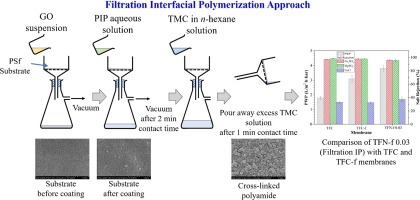当前位置:
X-MOL 学术
›
Arab. J. Chem.
›
论文详情
Our official English website, www.x-mol.net, welcomes your
feedback! (Note: you will need to create a separate account there.)
A Novel Interfacial Polymerization Approach Towards Synthesis of Graphene Oxide-incorporated Thin Film Nanocomposite Membrane with Improved Surface Properties
Arabian Journal of Chemistry ( IF 5.3 ) Pub Date : 2019-01-01 , DOI: 10.1016/j.arabjc.2017.12.009 G.S. Lai , W.J. Lau , P.S. Goh , Y.H. Tan , B.C. Ng , A.F. Ismail
Arabian Journal of Chemistry ( IF 5.3 ) Pub Date : 2019-01-01 , DOI: 10.1016/j.arabjc.2017.12.009 G.S. Lai , W.J. Lau , P.S. Goh , Y.H. Tan , B.C. Ng , A.F. Ismail

|
Abstract The conventional interfacial polymerization (IP) technique that requires a rubber roller in removing amine aqueous solution is likely to cause uneven distribution of nanomaterials on microporous substrate during thin film nanocomposite (TFN) membrane fabrication. A novel IP technique was developed in this work to pre-coat the substrate with graphene oxide (GO) nanosheets followed by vacuum filtration of amine aqueous solution through the substrate before initiating polyamide cross-linking process. This novel technique was also employed to fabricate a composite membrane that contained no nanomaterials. The results showed that the GO-incorporated TFN membrane exhibited 71.7% and 129.4% higher pure water flux compared to the composite membranes without GO incorporation that were synthesized using conventional and filtration IP technique, respectively. The water enhancement of the TFN membrane could be attributed to the existence of hydrophilic GO that was distributed evenly throughout the substrate surface coupled with the formation of porous selective layer that reduced water transport resistance. Besides exhibiting promising rejection against divalent ions, the newly developed TFN membrane also showed significantly lower water flux deterioration in filtrating bovine serum albumin and Reactive Black 5 solution. The enhanced membrane antifouling resistance was mainly due to the improved membrane surface properties that minimize deposition and adsorption of foulants on the TFN membrane surface.
中文翻译:

一种新型界面聚合方法,用于合成具有改善的表面性能的氧化石墨烯薄膜纳米复合膜
摘要 传统的界面聚合(IP)技术需要橡胶辊去除胺水溶液,在薄膜纳米复合(TFN)膜制备过程中可能会导致纳米材料在微孔基材上的分布不均匀。在这项工作中开发了一种新的 IP 技术,用氧化石墨烯 (GO) 纳米片预涂基材,然后在开始聚酰胺交联过程之前通过基材真空过滤胺水溶液。这种新技术还用于制造不含纳米材料的复合膜。结果表明,与使用常规和过滤 IP 技术合成的未掺入 GO 的复合膜相比,掺入 GO 的 TFN 膜的纯水通量提高了 71.7% 和 129.4%,分别。TFN 膜的水分增强可归因于亲水性 GO 的存在,该 GO 均匀分布在整个基材表面,加上多孔选择性层的形成降低了水传输阻力。除了对二价离子表现出良好的排斥性外,新开发的 TFN 膜在过滤牛血清白蛋白和 Reactive Black 5 溶液时也显示出显着较低的水通量劣化。增强的膜抗污性主要是由于改进的膜表面特性,最大限度地减少了污染物在 TFN 膜表面的沉积和吸附。TFN 膜的水分增强可归因于亲水性 GO 的存在,该 GO 均匀分布在整个基材表面,加上多孔选择性层的形成降低了水传输阻力。除了对二价离子表现出良好的排斥性外,新开发的 TFN 膜在过滤牛血清白蛋白和 Reactive Black 5 溶液时也显示出显着较低的水通量劣化。增强的膜抗污性主要是由于改进的膜表面特性,最大限度地减少了污染物在 TFN 膜表面的沉积和吸附。TFN 膜的水分增强可归因于亲水性 GO 的存在,该 GO 均匀分布在整个基材表面,加上多孔选择性层的形成降低了水传输阻力。除了对二价离子表现出良好的排斥性外,新开发的 TFN 膜在过滤牛血清白蛋白和 Reactive Black 5 溶液时也显示出显着较低的水通量劣化。增强的膜抗污性主要是由于改进的膜表面特性,最大限度地减少了污染物在 TFN 膜表面的沉积和吸附。新开发的 TFN 膜在过滤牛血清白蛋白和 Reactive Black 5 溶液时也显示出显着较低的水通量劣化。增强的膜抗污性主要是由于改进的膜表面特性,最大限度地减少了污染物在 TFN 膜表面的沉积和吸附。新开发的 TFN 膜在过滤牛血清白蛋白和 Reactive Black 5 溶液时也显示出显着较低的水通量劣化。增强的膜抗污性主要是由于改进的膜表面特性,最大限度地减少了污染物在 TFN 膜表面的沉积和吸附。
更新日期:2019-01-01
中文翻译:

一种新型界面聚合方法,用于合成具有改善的表面性能的氧化石墨烯薄膜纳米复合膜
摘要 传统的界面聚合(IP)技术需要橡胶辊去除胺水溶液,在薄膜纳米复合(TFN)膜制备过程中可能会导致纳米材料在微孔基材上的分布不均匀。在这项工作中开发了一种新的 IP 技术,用氧化石墨烯 (GO) 纳米片预涂基材,然后在开始聚酰胺交联过程之前通过基材真空过滤胺水溶液。这种新技术还用于制造不含纳米材料的复合膜。结果表明,与使用常规和过滤 IP 技术合成的未掺入 GO 的复合膜相比,掺入 GO 的 TFN 膜的纯水通量提高了 71.7% 和 129.4%,分别。TFN 膜的水分增强可归因于亲水性 GO 的存在,该 GO 均匀分布在整个基材表面,加上多孔选择性层的形成降低了水传输阻力。除了对二价离子表现出良好的排斥性外,新开发的 TFN 膜在过滤牛血清白蛋白和 Reactive Black 5 溶液时也显示出显着较低的水通量劣化。增强的膜抗污性主要是由于改进的膜表面特性,最大限度地减少了污染物在 TFN 膜表面的沉积和吸附。TFN 膜的水分增强可归因于亲水性 GO 的存在,该 GO 均匀分布在整个基材表面,加上多孔选择性层的形成降低了水传输阻力。除了对二价离子表现出良好的排斥性外,新开发的 TFN 膜在过滤牛血清白蛋白和 Reactive Black 5 溶液时也显示出显着较低的水通量劣化。增强的膜抗污性主要是由于改进的膜表面特性,最大限度地减少了污染物在 TFN 膜表面的沉积和吸附。TFN 膜的水分增强可归因于亲水性 GO 的存在,该 GO 均匀分布在整个基材表面,加上多孔选择性层的形成降低了水传输阻力。除了对二价离子表现出良好的排斥性外,新开发的 TFN 膜在过滤牛血清白蛋白和 Reactive Black 5 溶液时也显示出显着较低的水通量劣化。增强的膜抗污性主要是由于改进的膜表面特性,最大限度地减少了污染物在 TFN 膜表面的沉积和吸附。新开发的 TFN 膜在过滤牛血清白蛋白和 Reactive Black 5 溶液时也显示出显着较低的水通量劣化。增强的膜抗污性主要是由于改进的膜表面特性,最大限度地减少了污染物在 TFN 膜表面的沉积和吸附。新开发的 TFN 膜在过滤牛血清白蛋白和 Reactive Black 5 溶液时也显示出显着较低的水通量劣化。增强的膜抗污性主要是由于改进的膜表面特性,最大限度地减少了污染物在 TFN 膜表面的沉积和吸附。















































 京公网安备 11010802027423号
京公网安备 11010802027423号